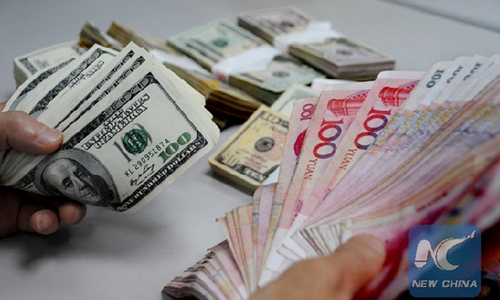Yuan may rise further after counter cyclical factor phase-out
Source: Global Times Published: 2020/10/28 19:23:42

A bank officer counts banknotes. Photo:Xinhua
Despite a dropping mid-point reference rate on Wednesday, the yuan, riding a cycle of appreciation now, is likely to rise further in the long run since China has announced plans to phase out the counter-cyclical factor in its reference rate system, experts said.
The yuan's mid-point rate against the US dollar edged down by 206 basis points to 6.7195 on Wednesday, according to data published by the People's Bank of China (PBC), the central bank.
On Tuesday, the Foreign Exchange Trading Center announced plans to gradually "phase out" the usage of the counter-cyclical factor in the yuan's central parity exchange rate system, based on "judgment about the market situation and China's economy."
Introduced in 2015, the counter-cyclical factor, an adjustment contributor banks make to the daily trade-weighted reference rate the central bank uses to guide the yuan, was meant to dampen depreciation pressure in the past years.
Zhou Yu, director of the Research Center of International Finance at the Shanghai Academy of Social Sciences, said that the counter-cyclical factor's function was to prevent the yuan from moving too violently in either direction.
However, it has not been a transparent mechanism because of ambiguity in its operation. It also runs counter to market reforms and will be ended "sooner than later," Zhou said.
"Removal of the factor demonstrates the policy trend to let market forces, instead of government intervention, decide the yuan's movement," Zhou told the Global Times on Wednesday.
Zhou said he was unsure about the relationship between the reference rate's drop on Wednesday and the phasing out of the counter-cyclical system.
"It [the drop] should be a correction of the yuan's continuous appreciation, and has little to do with the factor's removal," he said, adding that in the long run, the phasing out should theoretically lead to more volatility in the currency.
"As the yuan is now under pressure of appreciation, it should rise even faster with the factor being removed," Zhou said.
The yuan has risen against the US dollar in recent months as China's economic fundamentals improved and the coronavirus epidemic was brought under firm control.
Since late May, the onshore yuan has gained about 6 percent. The offshore yuan edged down by 0.0045 percent to 6.7112 as of 3:53 pm (Beijing time) on Wednesday.
Posted in: MARKETS